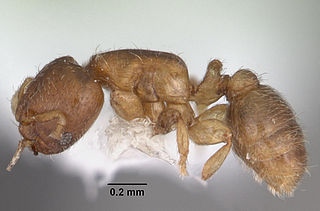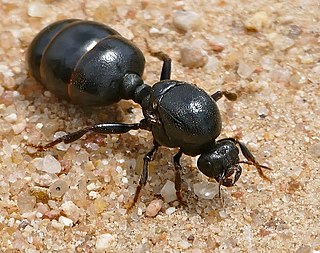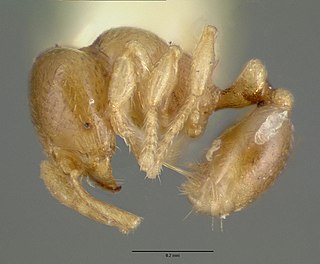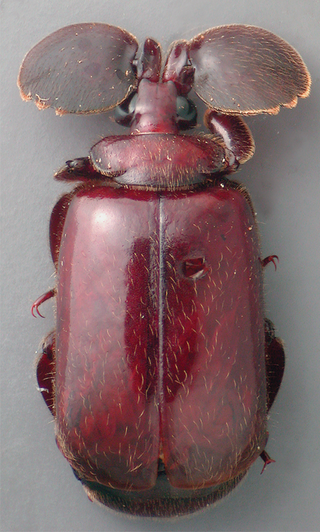
The Texas leafcutter ant is a species of fungus-farming ant in the subfamily Myrmicinae. It is found in Texas, Louisiana, and north-eastern Mexico. Other common names include town ant, parasol ant, fungus ant, cut ant, and night ant. It harvests leaves from over 200 plant species, and is considered a major pest of agricultural and ornamental plants, as it can defoliate a citrus tree in less than 24 hours. Every colony has several queens and up to 2 million workers. Nests are built in well-drained, sandy or loamy soil, and may reach a depth of 6 m (20 ft), have 1000 entrance holes, and occupy 420 m2 (4,500 sq ft).
Phragmosis is any method by which an animal defends itself in its burrow, by using its own body as a barrier. This term was originally coined by W.M. Wheeler (1927), while describing the defensive technique exhibited by insects. Wheeler observed the positioning of specially modified body structures to block nest entrances, as exhibited in various insect species. The term phragmosis has since been further extended beyond just insects.

Crematogastrini is a tribe of myrmicine ants with 64 genera and 8 fossil genera.

Carebara diversa, the East Indian harvesting ant, is a species of marauder ant widely distributed throughout Asia.

Carebara is a genus of ants in the subfamily Myrmicinae. It is one of the largest myrmicine genera with more than 200 species distributed worldwide in the tropics and the Afrotropical region. Many of them are very tiny cryptic soil and leaf-litter inhabitants. They nest in rotten wood to which the bark is still adherent in the Afrotropical region, or may be lestobiotic nesting near other ant species. Some species are known to exist parasitically within termite nests. Little is known about the biology of the genus, but they are notable for the vast difference in size between queens and workers.

Rhopalomastix is a genus of ants in the subfamily Myrmicinae. It is restricted to the Oriental and Indo-Australian regions, where the ants nest under the bark of living trees.

Carebara vidua is a species of ant in the subfamily Myrmicinae. It is currently listed as endangered because it is overly consumed for protein and used for medicine.
Carebara escherichi is a species of ant in the subfamily Formicinae. It is found in Sri Lanka.
Carebara bruni is a species of ant in the subfamily Myrmicinae. It is found in Sri Lanka and China.
Carebara ceylonensis is a species of ant in the subfamily Formicinae. It is found in Sri Lanka.
Carebara deponens is a species of ant in the subfamily Formicinae. It is found in Sri Lanka.

Cardiocondyla minutior is a species of ant in the subfamily Myrmicinae. It is a widespread ant species, and not invasive in nature.
Carebara pygmaea is a species of ant in the subfamily Formicinae. It is found in Sri Lanka, Borneo, Indonesia, Philippines.
Carebara sinhala is a species of ant in the subfamily Formicinae. It is found in Sri Lanka.

The bicolored trailing ant or flower ant is a species of ant of the subfamily Myrmicinae. It is a widespread, invasive ant which is found all over the world.
Pheidole noda is a species of ant in the subfamily Myrmicinae. It is found in Indonesia, Bangladesh, India, Taiwan, Thailand, Vietnam, Sri Lanka, Japan and South Korea.

Carebara armata is a species of ant from the subfamily Myrmicinae. The scientific name of this species was first published in 1948 by Horace Donisthorpe.

Carebara castanea is a species of ant from the Myrmicinae subfamily. The scientific name of this species was first published in 1858 by Smith. It is found in Thailand, Laos, and China.

Platyrhopalopsis melleii is a species of ant-nest or flanged bombardier beetle found in southern India. They live inside the nests of ants of the genus Carebara and adults are only rarely seen in the open, most often at night when they get attracted to lights.










